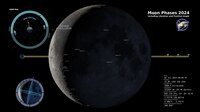phases of the moon

Phases of the moon is something that happens every month. When you look up at the sky, you can see the moon, which is a big rocky ball in the sky. Every month, the moon looks a little bit different. That's because of the phases of the moon.
The moon's phases happen because the moon goes around the Earth in an oval-shaped path, and the way the sun's light hits the moon changes as it moves. The moon looks bigger to us when the sun's light is shining on it and smaller when the sun's light isn't shining on it.
The moon has four main phases: new moon, waxing crescent, full moon, and waning crescent.
The new moon is when we can't see the moon in the night sky because the side of the moon that's facing us doesn't have any sunlight on it. As the moon moves in its path, it slowly starts to show a bit of its bright side, looking like a crescent (half circle) shape in the sky. This is called the waxing crescent.
Then the moon moves some more and the whole bright side is lit up by the sun, like a big circle in the sky. This is called the full moon. After the full moon, the moon starts to look like a crescent shape again, but this time it's the other way around - it's the side of the moon that's facing away from us that's lit up by the sun. This is called the waning crescent.
Finally, the moon finishes its journey and goes back to the new moon, and the cycle starts over.
The moon's phases happen because the moon goes around the Earth in an oval-shaped path, and the way the sun's light hits the moon changes as it moves. The moon looks bigger to us when the sun's light is shining on it and smaller when the sun's light isn't shining on it.
The moon has four main phases: new moon, waxing crescent, full moon, and waning crescent.
The new moon is when we can't see the moon in the night sky because the side of the moon that's facing us doesn't have any sunlight on it. As the moon moves in its path, it slowly starts to show a bit of its bright side, looking like a crescent (half circle) shape in the sky. This is called the waxing crescent.
Then the moon moves some more and the whole bright side is lit up by the sun, like a big circle in the sky. This is called the full moon. After the full moon, the moon starts to look like a crescent shape again, but this time it's the other way around - it's the side of the moon that's facing away from us that's lit up by the sun. This is called the waning crescent.
Finally, the moon finishes its journey and goes back to the new moon, and the cycle starts over.
Related topics others have asked about:
